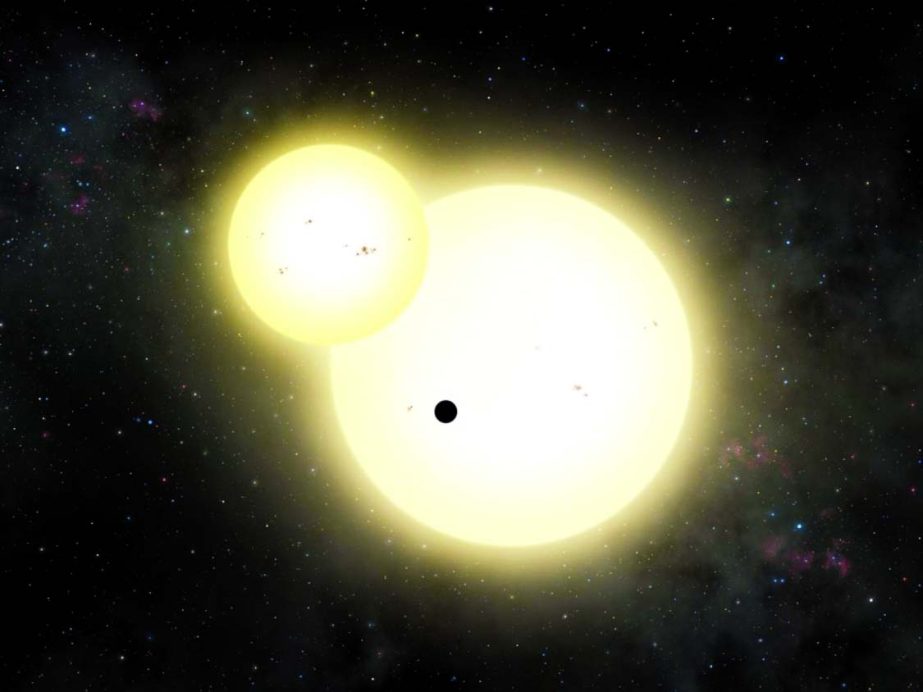
The Washington Post :Some worlds have more than one sun in their sky. Now scientists say they’ve confirmed the existence of the largest-ever planet orbiting a pair of binary stars – a gas giant with the same mass and radius as Jupiter. Exoplanets like this one – situated in their stars’ habitable zone and massive enough to lasso in many rocky moons – could be an interesting place to go looking for signs of alien life.The newly confirmed behemoth has been dubbed Kepler-1647 b, and it sits 3,700 light-years away in the constellation Cygnus. At an estimated 4.4 billion years old, it’s roughly the same age as Earth. But it’s nothing like our home planet. It’s what is known as a circumbinary world – one that orbits two suns that dance together as a binary pair – and it’s the size of Jupiter, a planet with a diameter more than 11 times that of Earth’s. Its suns are pretty similar to our own (one is slightly smaller and the other slightly larger) but, well, there are two of them.At about 2.7 astronomical units (AUs) from its suns (Earth is 1 AU from ours) Kepler-1647 b is in the habitable zone of its stars. That means it’s in the magic sweet spot that experiences the right amount of sunlight and heat to allow liquid water to form. But the planet itself wouldn’t actually be home to life as we know it: It’s almost entirely made of gas. If it’s anything like the gas giants in our solar system, however, it likely has dozens of moons – and just like the moons that orbit Saturn and Jupiter, those little rocky worlds could be great places to look for life like ours.Scientists find exoplanets by measuring the way the light of their host stars dim when the planets “transit,” or pass in front of the stars from our perspective. This is way harder to do with circumbinary planets, or CBP. “CBPs are harder to detect because their transits are not strictly periodic,” Veselin Kostov, a NASA Goddard postdoctoral fellow and lead author of a soon-to-be-published study on the planet, told The Washington Post in an email. “A planet around a single star is like a clock. For example, if you are outside the solar system and can see Earth in transit, you’ll see the transit every year. Every 365 days you’ll see a tiny decrease in the light from the Sun as Earth moves across its disk. In contrast, when a circumbinary planet transits, the consecutive events can be early or late by many days. Sometimes, the transits of a CBP can even cease altogether, only to reappear decades, even centuries later,” he said.You might think that Kepler-1647 b, being significantly larger than previously discovered CBP (all around the size of Saturn or smaller) would make a heftier dim and therefore be easier to spot. But it was actually pretty hard to pin down: Kepler-1647 b has the longest orbit of any CBP ever detected. That distance from its host stars is good news for the potential for life on its moons, because it keeps them from getting too hot for liquid water. But since it takes 1,107 days for the planet to complete an orbit, the transit events that scientists can use to study it are few and far between.”The first transit was detected way back in 2011, but with one transit it’s hard or impossible to tell what’s going on,” Kostov said. “So we had to wait for three years for the planet to transit again, during which time we kept a close eye in the system, analyzing the available data and gathering new observations.”The Internet of Things (IoT) has the potential to solve our biggest global challenges and bring people everywhere a better quality of life.Scientists like to study systems with multiple host stars because they help us understand the myriad ways in which solar systems can evolve: It’s been just a few years since we confirmed that planets could form in these strange, star-heavy systems, and now we know that in addition to (relatively) small planets kept in close orbit, the systems can develop large, slightly further-flung planets.”Habitability aside, Kepler-1647 b is important because it is the tip of the iceberg of a theoretically predicted population of large, long-period circumbinary planets,” study co-author William Welsh of San Diego State University said in a statement.

